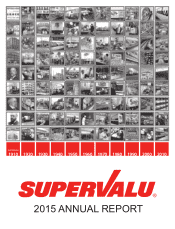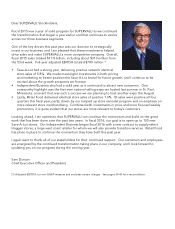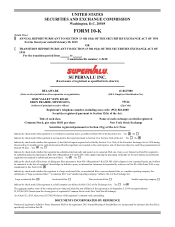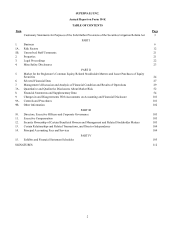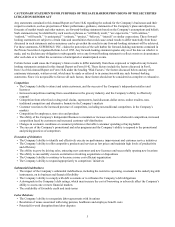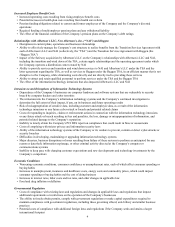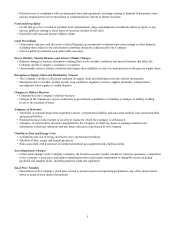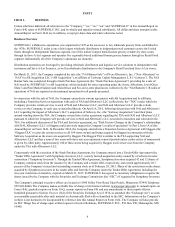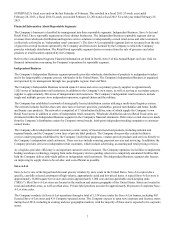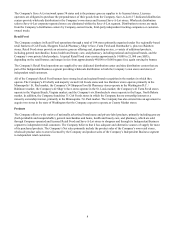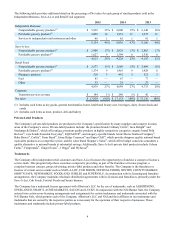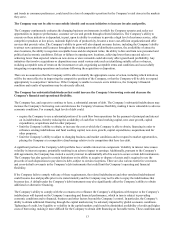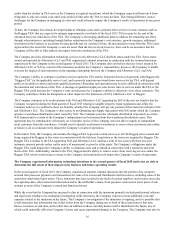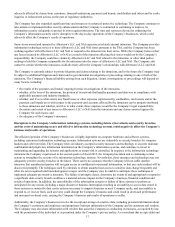Albertsons 2015 Annual Report Download - page 9
Download and view the complete annual report
Please find page 9 of the 2015 Albertsons annual report below. You can navigate through the pages in the report by either clicking on the pages listed below, or by using the keyword search tool below to find specific information within the annual report.7
SUPERVALU's fiscal year ends on the last Saturday of February. This resulted in a fiscal 2015 53-week year ended
February 28, 2015, a fiscal 2014 52-week year ended February 22, 2014 and a fiscal 2013 52-week year ended February 23,
2013.
Financial Information About Reportable Segments
The Company’s business is classified by management into three reportable segments: Independent Business, Save-A-Lot and
Retail Food. These reportable segments are three distinct businesses. The Independent Business reportable segment derives
revenues from wholesale distribution and logistics service solutions to independently-owned retail stores and other customers
(collectively referred to as “independent retail customers”). The Save-A-Lot reportable segment derives revenues from the sale
of groceries at retail locations operated by the Company and from stores licensed by the Company to which the Company
provides wholesale distribution. The Retail Food reportable segment derives revenues from the sale of groceries and other
products at retail locations operated by the Company.
Refer to the Consolidated Segment Financial Information set forth in Part II, Item 8 of this Annual Report on Form 10-K for
financial information concerning the Company’s operations by reportable segment.
Independent Business
The Company’s Independent Business segment primarily provides wholesale distribution of products to independent retailers
and is the largest public company grocery wholesaler in the United States. The Company's Independent Business is organized
and operated by its management through two geographic regions: East and West.
The Company’s Independent Business network spans 41 states and serves as primary grocery supplier to approximately
1,825 stores of independent retail customers, in addition to the Company’s own stores, as well as serving as secondary grocery
supplier to approximately 208 stores of independent retail customers. The Company’s independent retail customers include
single and multiple grocery store independent operators, regional chains and the military.
The Company has established a network of strategically located distribution centers utilizing a multi-tiered logistics system.
The network includes facilities that carry slow turn or fast turn groceries, perishables, general merchandise and home, health
and beauty care products. The network is comprised of 17 distribution facilities, nine of which supply the Company’s own
Retail Food stores in addition to stores of independent retail customers. Wholesale distribution sales to Retail Food stores are
eliminated within the Independent Business segment in the Company's financial statements. Deliveries to retail stores are made
from the Company’s distribution centers by Company-owned trucks, third-party independent trucking companies or customer-
owned trucks.
The Company offers independent retail customers a wide variety of food and non-food products, including national and
regional brands, and the Company’s own lines of private label products. The Company also provides certain facilitative
services under programs established by the Company. Under these programs, vendors provide products and services directly to
the Company’s independent retail customers. These services include sourcing, payment services and invoicing. In addition, the
Company provides services to independent retail customers, which include advertising, accounting and retail pricing services.
As a logistics provider, efficiency is an important customer service measure. The Company optimizes its facilities to implement
leading warehouse technology, ranging from radio-frequency devices guiding selectors to completely automated facilities that
help the Company deliver aisle-ready pallets to independent retail customers. The Independent Business segment also focuses
on improving its supply chain to be as labor- and cost-efficient as possible.
Save-A-Lot
Save-A-Lot is one of the largest hard discount grocery retailers by store count in the United States. Save-A-Lot provides a
specific, carefully selected assortment of high volume, appropriately sized and low priced items. A typical Save-A-Lot store is
approximately 16,000 square feet in size and carries approximately 3,000 core and non-perishable stock-keeping units
("SKUs"). Most Save-A-Lot stores are located in the southern and eastern geography of the United States. Stores are located in
rural and suburban areas, as well as urban areas. Private label products account for approximately 60 percent of corporate Save-
A-Lot store sales.
The Company conducts its Save-A-Lot operations through a total of 1,334 stores under the Save-A-Lot banner, including 903
licensed Save-A-Lot stores and 431 Company-operated stores. The Company expects to open new corporate and licensee stores
during fiscal 2016, including in existing and new geographic markets, with the majority of those stores expected to be corporate
stores.

